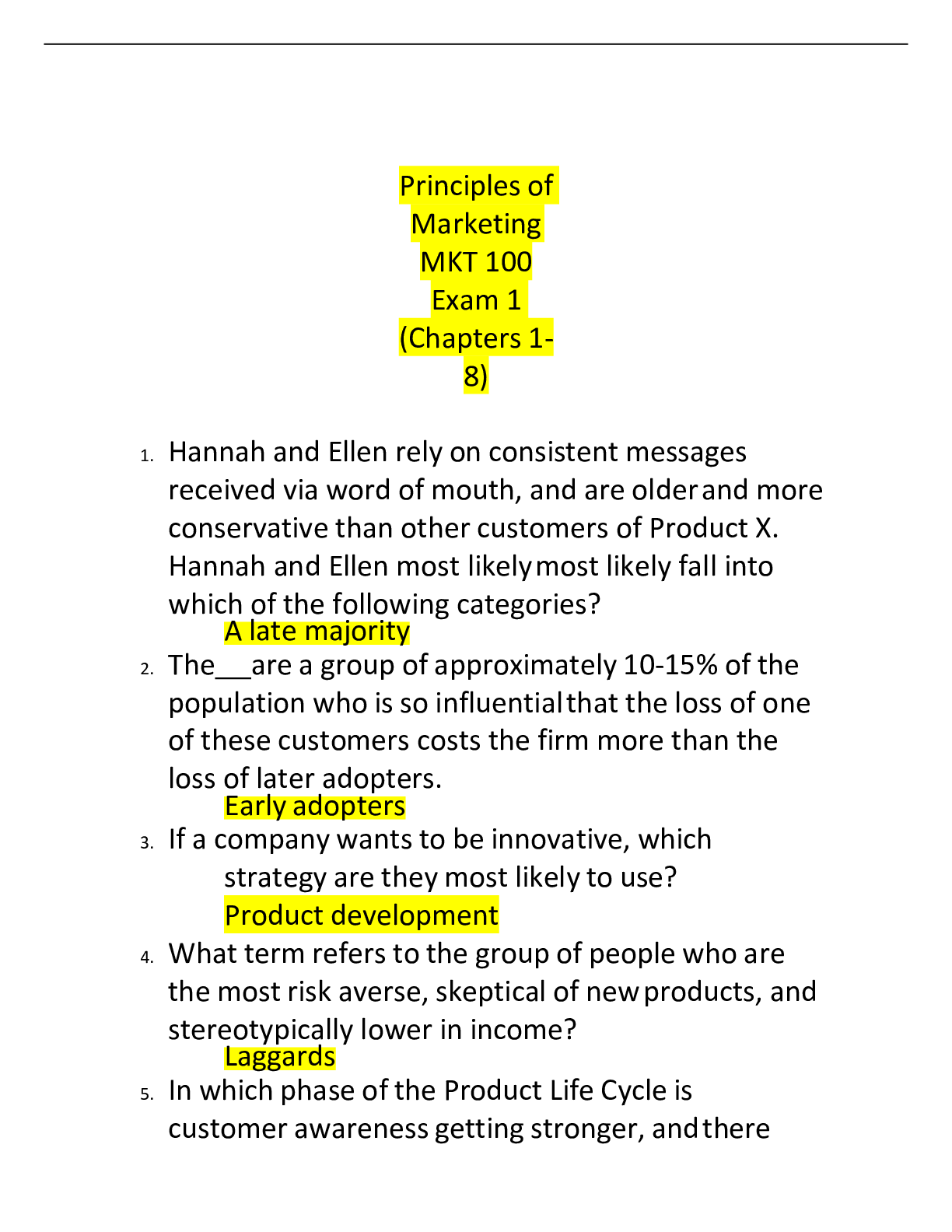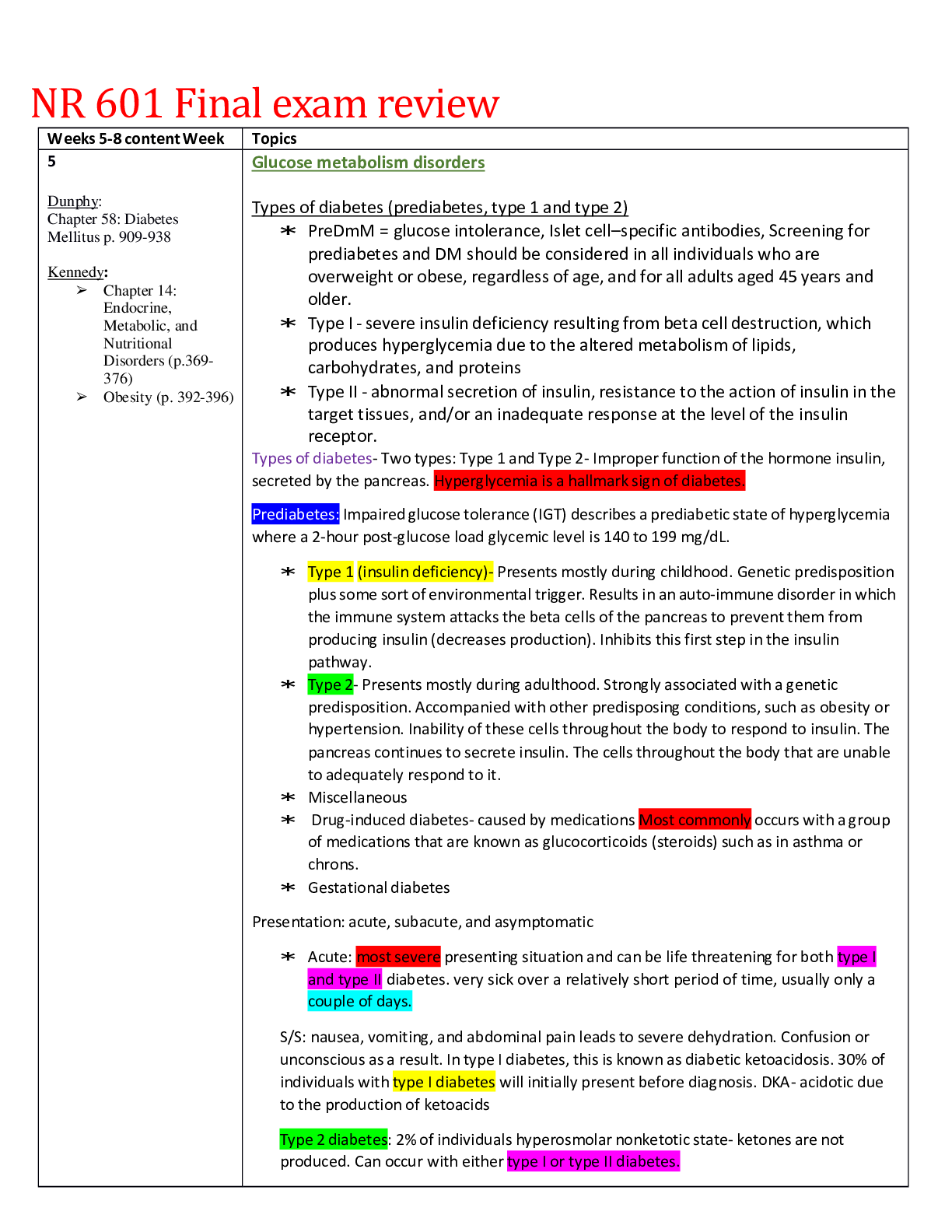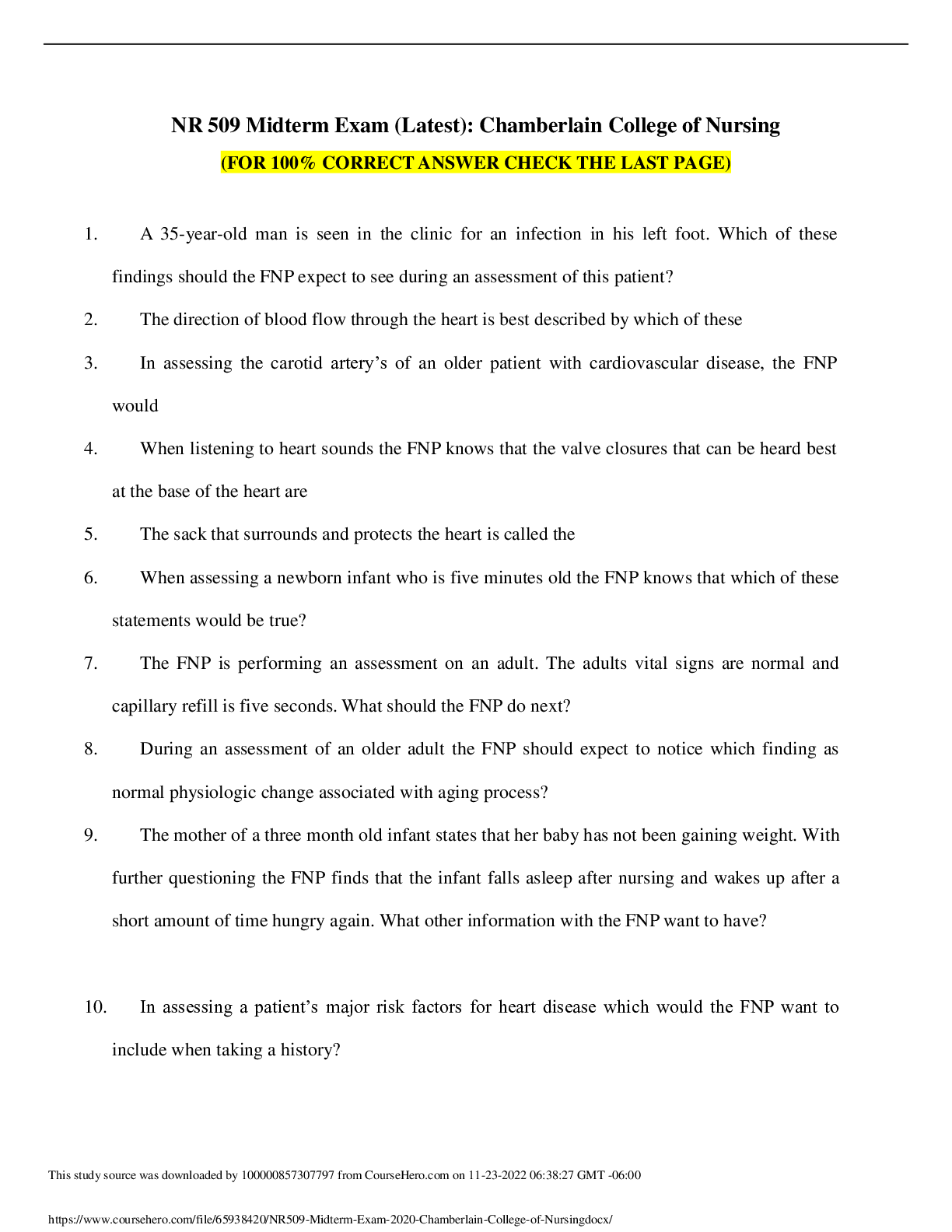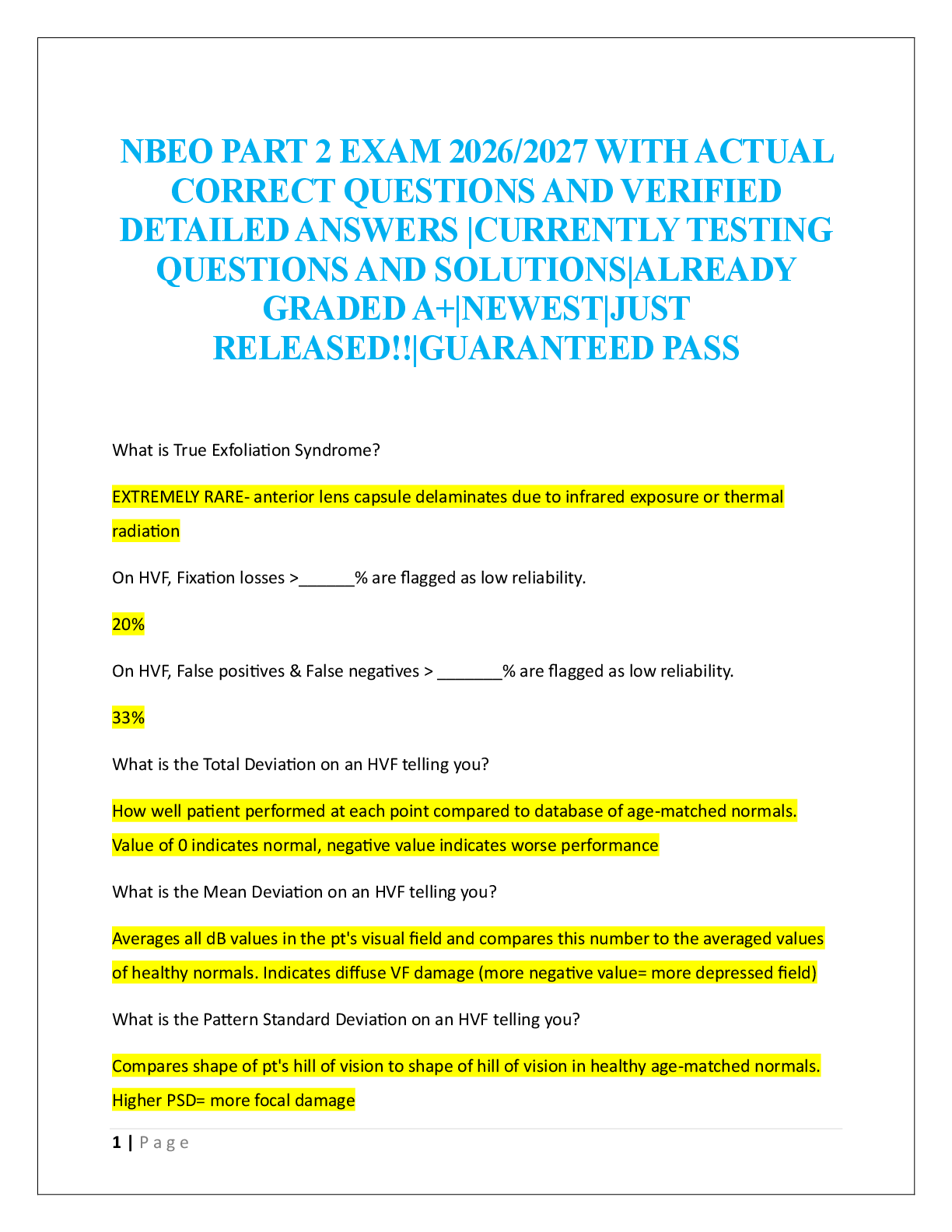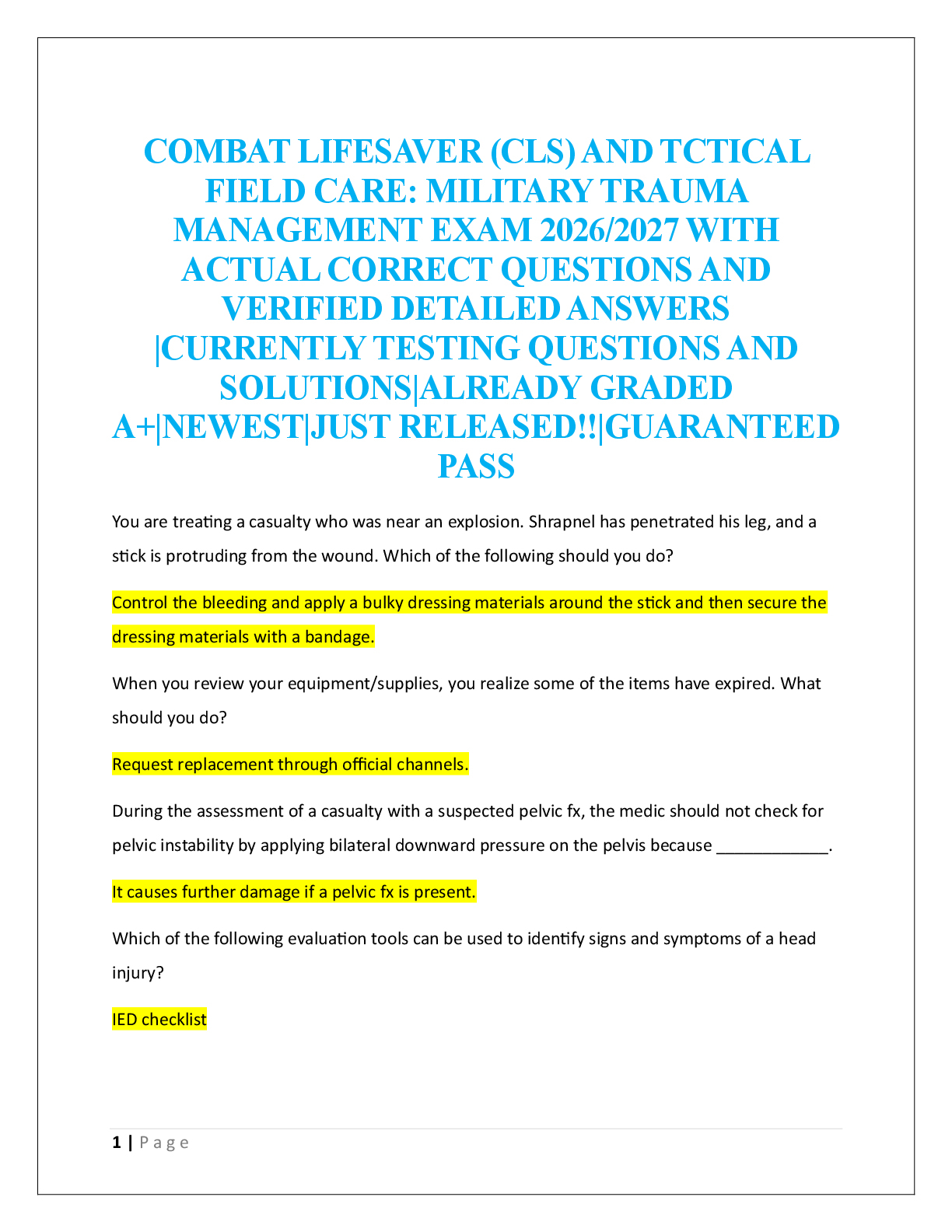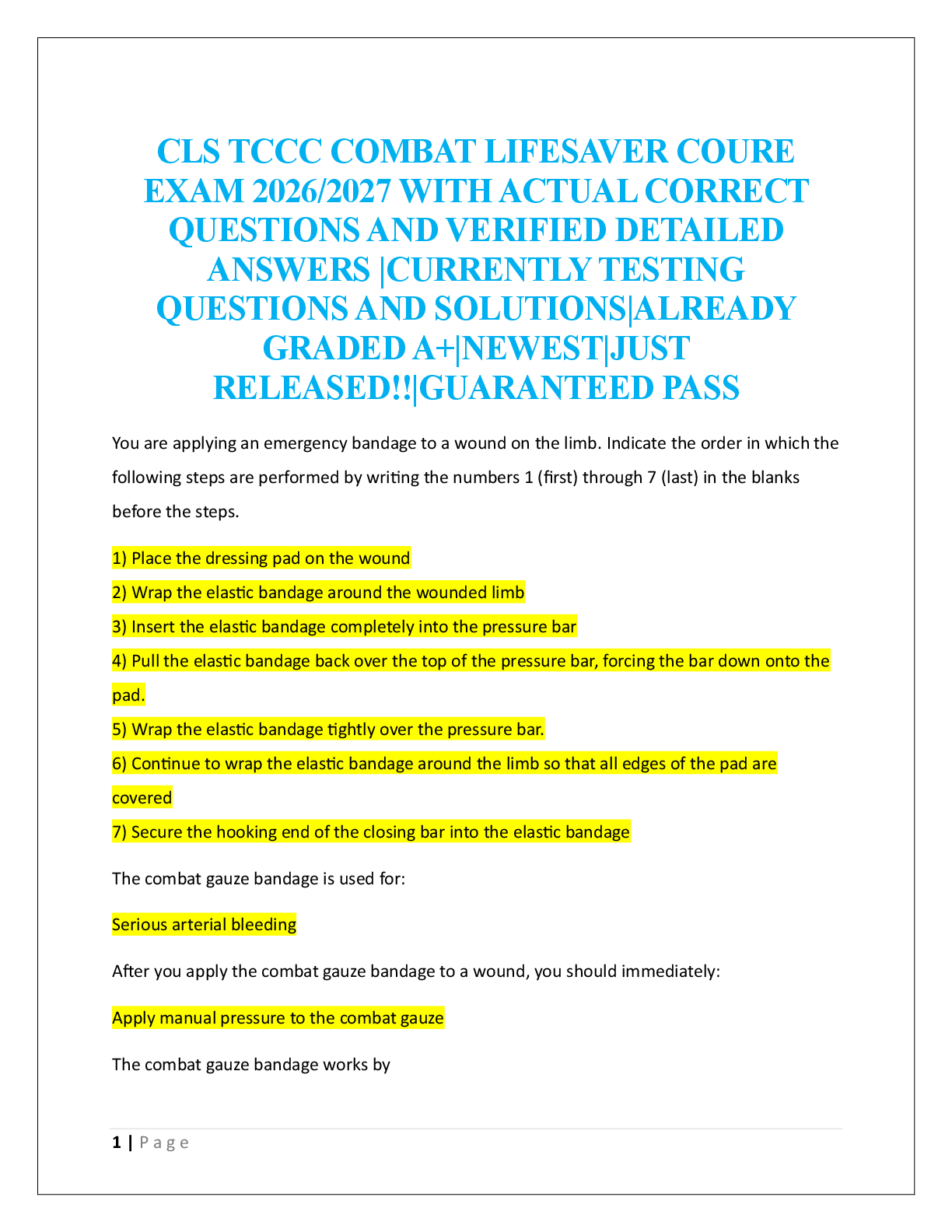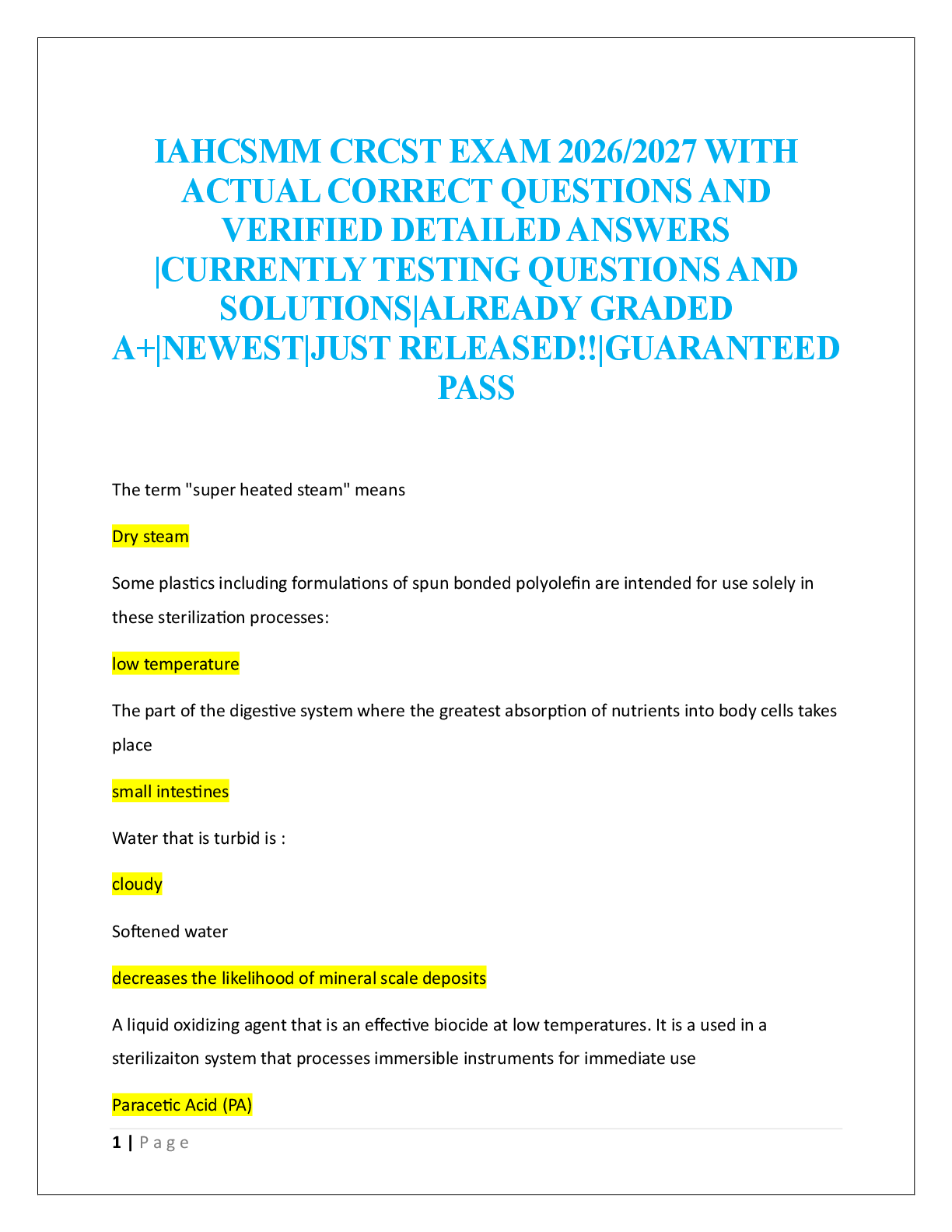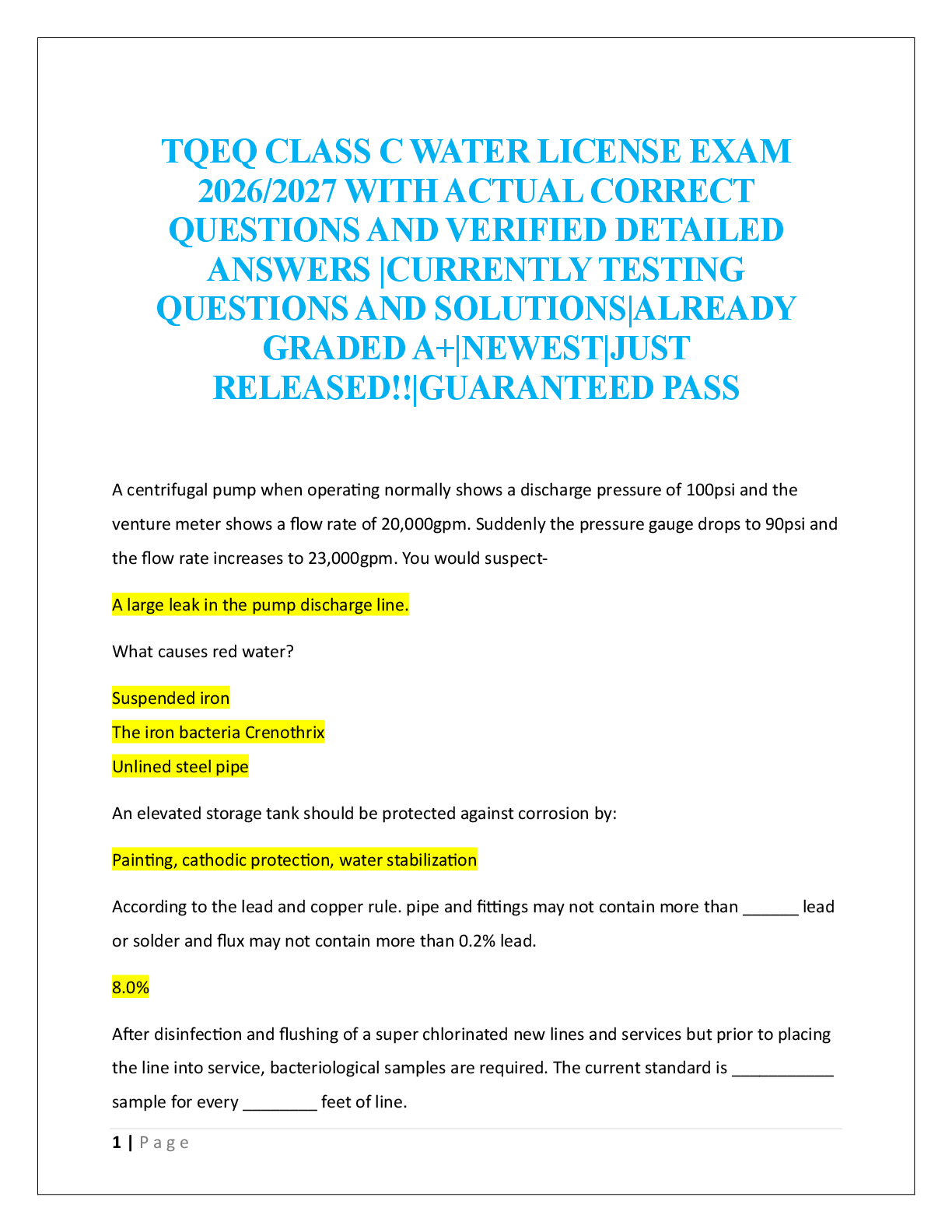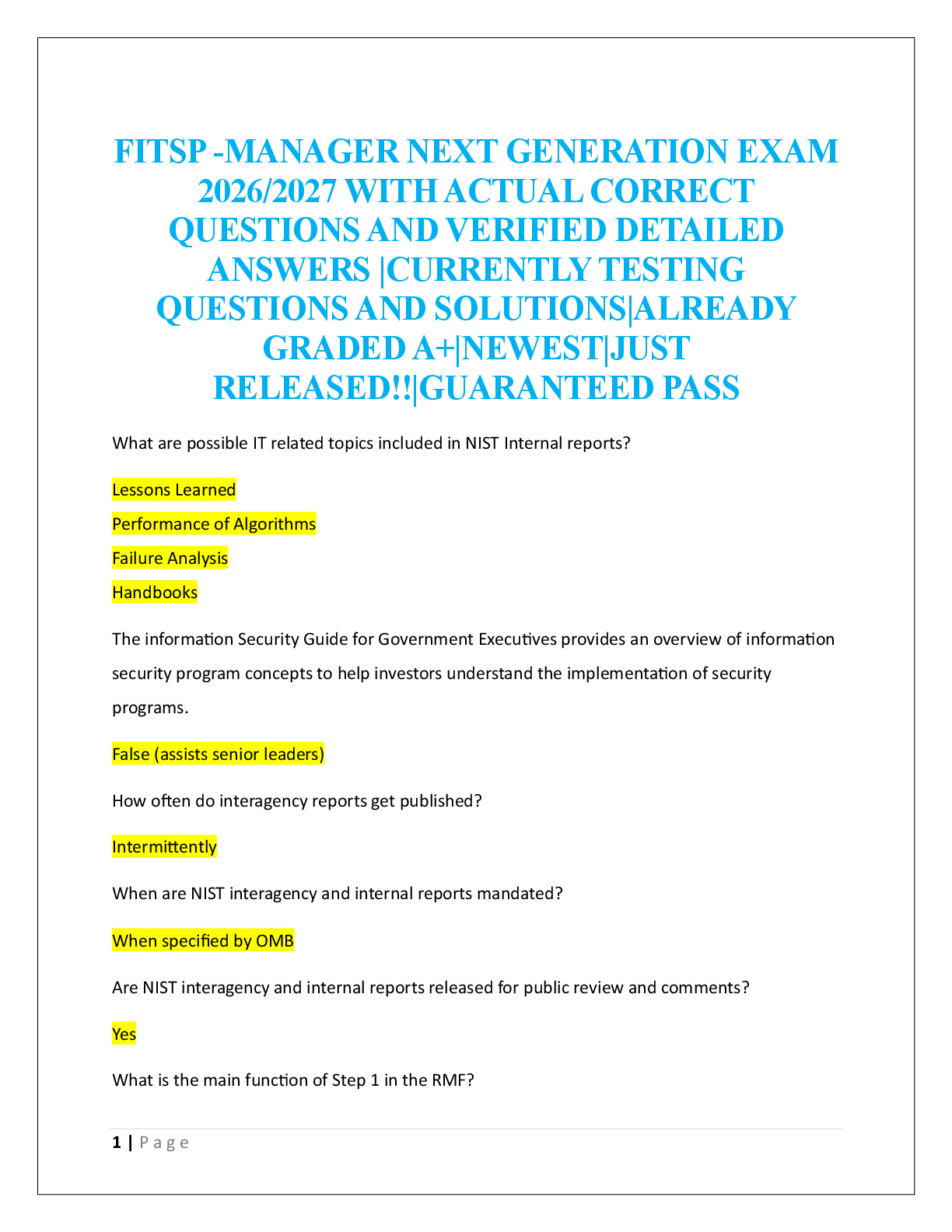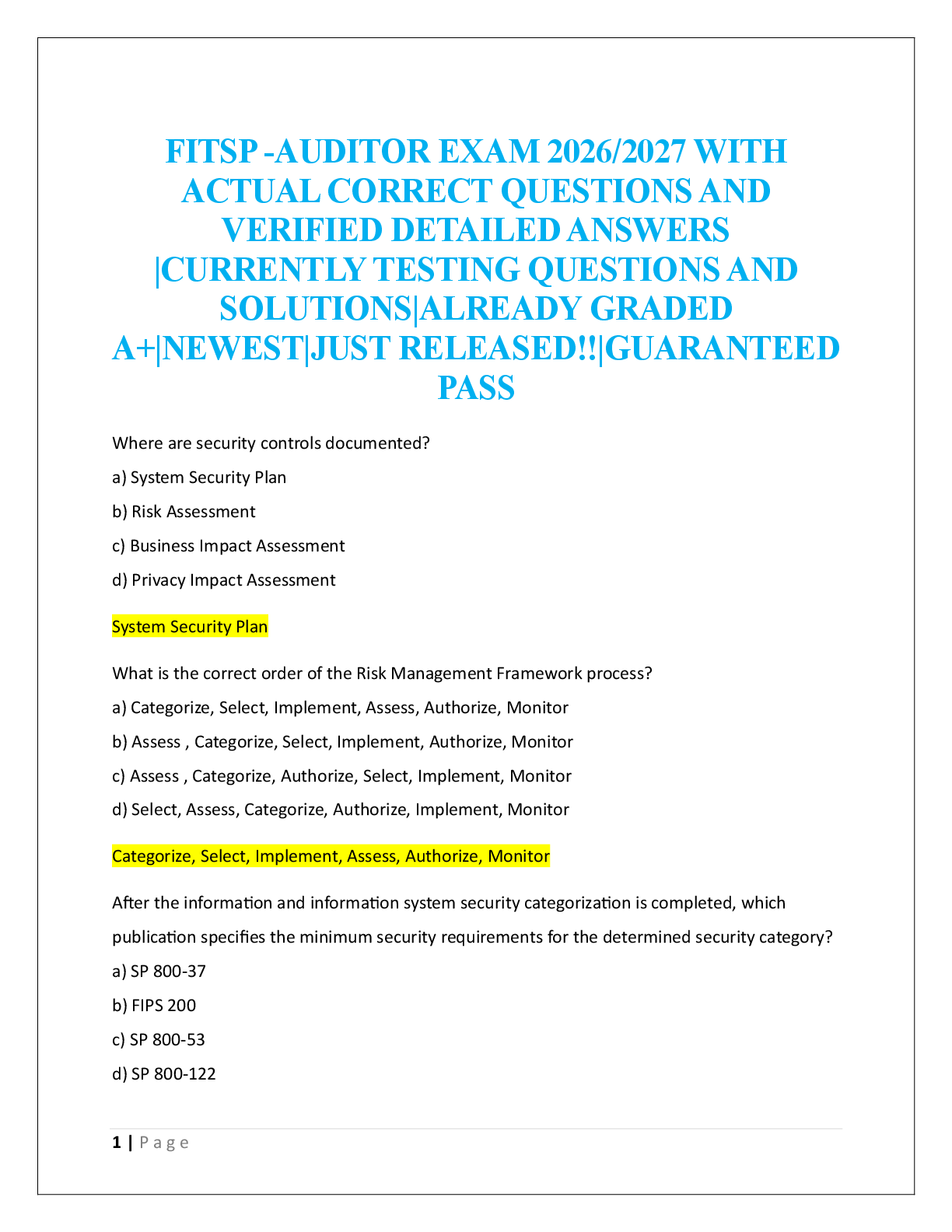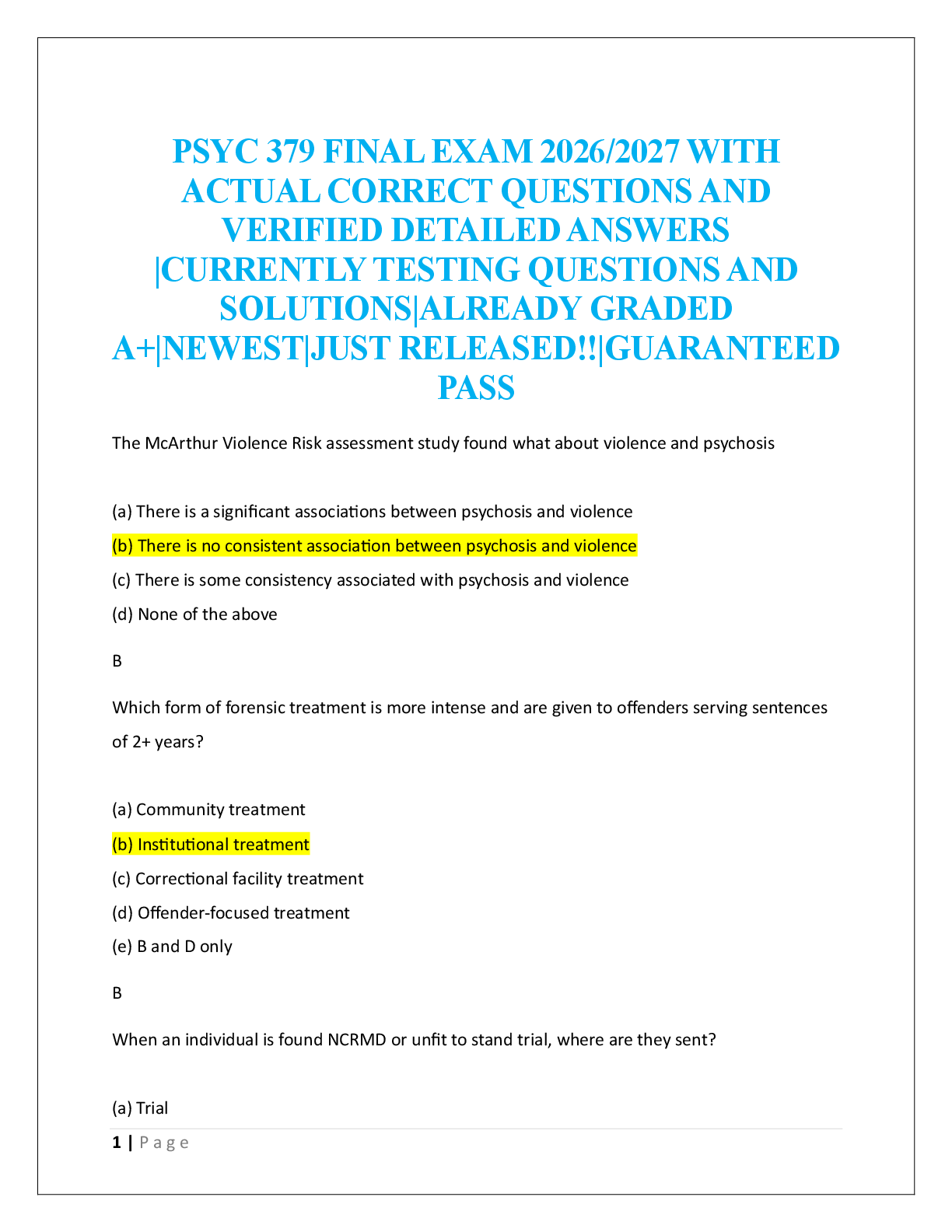Macroeconomics > EXAM > ECO 102 Macroeconomics Unit 3 Challenge 1,2 and 3 Sophia Course (Exam type questions, perfect revisi (All)
ECO 102 Macroeconomics Unit 3 Challenge 1,2 and 3 Sophia Course (Exam type questions, perfect revision tool).
Document Content and Description Below
When store owners quote prices in terms of dollars, money is acting as a . • d.) The double coincidence of wants challenge is faced when we . When I use money to purchase a movie ticket, my dolla ... rs are acting as a . ECO 102 Macroeconomics Unit 3 Challenge 1,2 and 3 Sophia Course Unit 3 Challenge 1 Challenge 1 • a.) commodity • b.) medium of exchange • c.) store of value • a.) use money as a medium of exchange • b.) establish gold as a commodity • c.) use gold as a unit of account • d.) attempt to barter to attain goods • a.) unit of account Which of the following choices is a reason why gold became a form of currency? As the use of gold as currency became more standardized, what happened to the gold trade? • b.) Which of the following describes what happened to the gold trade as the use of gold as currency became more standardized? unit of account • b.) store of value • c.) bartering agreement • d.) medium of exchange • a.) It has little practical value. • b.) It is the most liquid form of money. • c.) It contributes to inflation. • d.) It is almost impossible to counterfeit. • a.) Americans lost faith in their currency and hoarded gold. • c.) Gold held little practical value other than as jewelry. • d.) The dollar's convertibility was suspended. Banks printed paper money to represent a specific amount of gold in the vault. What is the central issue that causes bank runs and panics? • a.) Banks print more money than they have gold in their vaults Which of the following can be described as when a bank holds a part of its gold and loans out the rest? • a.) People began to write checks instead of actually transferring gold. • b.) Certain commodities became accepted as forms of exchange. • c.) Banks figured out that they could print more money than gold that they had in their vaults. • d.) Traders faced a double coincidence of wants. • b.) Banks fail to pay interest to their depositors • c.) Banks withhold deposits from creditors • d.) Banks do not loan out enough funds to stimulate the economy • a.) Fiduciary money • b.) Deposit account • c.) Fiat currency Which of the following statements about fiat currency is true? Some of the founding fathers were initially against a Central Bank because . • a.) the control of the English bank over the colonies • d.) Fractional reserve • a.) Fiat currency has intrinsic value. • b.) Fiat currency is dependent on trust that it will be widely accepted. • c.) Fiat currency is not available in America today. • d.) Fiduciary currency has value based on the trust of the Federal Reserve. Which answer below explains why some might have FAVORED the old banking system? • a.) Currency traders could make a lot of money by exchanging it between cities. • b.) All of the account holders at a bank could create a run by asking to withdraw their funds at the same time. • c.) The value of notes from unknown banks was unclear. • d.) Prices were uncertain in trading over long distances. • b.) the 'Continental' currency had already been issued Before a Central Bank was established in the United States, people known as were able to buy and sell the monies from individual states. • d.) A central bank is charged with the regulation of money supply and interest rates. • c.) different states wanted their own currency • d.) they couldn't agree which branch of government would control a Central Bank • a.) the Board of Governors • b.) federal funds traders • c.) equity salesmen • d.) currency traders Which of the following statements regarding central banks is true? • a.) As the value of the currency becomes more certain, people rely more on commodity standards. • b.) A run could never happen at a central bank. • c.) Banks are not required to maintain cash on hand. Which of the following statements regarding central banks is true? • a.) Central banks undermine international trade. Which of the following describes a way that central banks strengthened the value of currency? Which of the following statements about the Federal Reserve is true? • b.) Central banks require greater reliance on the gold standard. • c.) A central bank has the sole authority with respect to the money supply. • d.) A central bank controls the state and local bank locations and number of branches. • a.) Banks lent out more money than is kept in reserves. • b.) Over time, the banking system becomes less reliant on the gold standard. • c.) Traders made a living by exchanging currency between cities. • d.) People deposited paper money instead of gold in banks. • a.) The members of the Board of Governors of the Federal Reserve are appointed for terms of 14 years. • b.) The Federal Reserve Board of Governors are elected by the general public. • c.) The Federal Reserve prints more money to prevent runs on banks. • d.) The Federal Reserve is directly controlled by the government, as its members are all elected politicians. • c.) Which of the following statements is NOT true of the Federal Reserve? Select the answer below that has the three examples of money in order from most liquid to least liquid. • a.) It doesn't; banks need to establish good reputations on their own • b.) By printing more money if necessary • d.) By guaranteeing people's deposits • a.) The Federal Reserve prints more money to prevent runs on banks. • b.) The Federal Reserve was created to sustain long term economic health. • c.) The Federal Reserve is independent from the federal government. • d.) The Federal Reserve prevents panics by allowing private banks to hold reserves at regional Federal Reserve banks. Challenge 2 • a.) Checking account balances, dollar bills, money market mutual funds • b.) Savings account balances, checking account balances, dollar bills By acting as a lender of last resort to member banks How does the Federal Reserve prevent runs on banks? • d.) Which of the following statements regarding different types of money is true? The M1 definition of money includes . If the reserve requirement of a bank is 50%, then the multiplier effect will be and $100 in M1 will increase the money supply by . • a.) • c.) Money market mutual funds, checking account balances, dollar bills • a.) Different types of money all have the same level of liquidity. • b.) Time deposits belong in the least liquid category of money. • c.) There are five main categories of money, based on liquidity. • d.) A checking account is a form of M0. • a.) demand deposits and time deposits • b.) physical currency only • c.) demand deposits only • d.) physical currency and demand deposits 2; $200 Dollar bills, checking account balances, money market mutual funds If the reserve requirement of a bank is 25%, then the multiplier effect will be and $200 in M1 will increase the money supply by . If the reserve requirement of a bank is 20%, then the multiplier effect will be and $50 in M1 will increase the money supply by . • b.) 2; $50 • c.) 0.5; $50 • d.) 0.5; $200 • a.) 25; $50 • b.) 4; $800 • c.) 4; $50 • d.) 25; $800 • a.) 20; $250 • b.) 5; $250 • c.) 20; $1,000 • d.) 5; $1,000 • d.) When the Fed sells bonds, the result is an increase in . What is the result when the Federal Reserve buys Treasury bonds? • a.) If the Fed wants to reduce the money supply, it sells bonds and shreds the money it receives. • b.) The Fed gives bondholders cash in exchange for securities (bonds). • c.) Money that is printed by the Bureau of Printing and Engraving is turned over to the Fed. • a.) interest rates • b.) money supply • c.) consumption (C) • d.) investment (I) • a.) More currency in the hands of the public • b.) Higher interest rates • c.) Less consumption (C) • d.) The U.S. Treasury sends the money it prints directly into circulation. Which statement is NOT true regarding the way that the Federal Reserve controls the money supply? The federal funds rate is paid to . Which of the following statements is true as it relates to banks and the federal funds market? • c.) Fed member banks enter the federal funds market in order to . Fewer investments (I) • a.) the Federal Open Market Committee for overseeing the Federal Funds rate • b.) banks who lend excess reserves to other member banks • c.) depositors whose funds are loaned out to member banks • d.) banks that need to borrow in order to meet the reserve requirement • a.) The FOMC uses taxation to control our money supply. • b.) The federal funds market developed as banks lost customers. • d.) The federal funds rate is charged on an annual basis. • a.) increase the interest rate they can charge on loans • b.) boost profits • c.) meet reserve requirements Banks with less than the reserve requirement need overnight loans to meet their obligations. Why would banks need to borrow directly from the Fed? • c.) Which statement below is true about the discount rate? Which statement below is true about the discount rate? • d.) increase their size and importance • a.) To meet monthly deposit target goals • b.) To increase the interest rate they can charge to lenders • d.) To purchase Federal Treasury bonds on the open market • a.) It involves banks loaning funds to one another so that they can meet their reserve level. • b.) It dictates the amount of money that banks should maintain in their vaults at all times. • c.) It is influenced by the multiplier effect. • d.) It is the rate that the Fed charges member banks for short term loans. • a.) It is the same as the fed funds rate. • b.) This is the rate used when banks borrow directly from the Fed. • c.) It is the rate that banks charge other banks to loan money overnight. • d.) It is the interest rate that the federal government pays to the public via the sale of Treasury securities. To meet the reserve requirement • d.) Which of the following statements regarding goals of monetary policy is FALSE? • a.) Which of the following statements is associated with deflation? • a.) When the unemployment rate is under 5%, inflation is not a concern anymore. • b.) According to most economists, an annual inflation rate of 8% is normal and just fine. • c.) Decreasing the discount rate is one way to combat inflation. • b.) Extreme inflation has the potential to destroy a currency completely. • c.) Most economists say that a 2% annual inflation rate is normal. • d.) One of the Fed's main goals is to promote economic stability. • a.) In extreme cases, this can force people to revert back to a barter economy. • b.) Prices fall, but loan payments stay the same. • c.) It decreases the real value of debt. • d.) Prices increase so quickly that it hurts trade. The Fed might seek to reduce inflation by increasing the money supply. When inflation is extreme, it can destroy a country's currency. Which of the following statements regarding inflation is true? Which of the following is associated with contractionary monetary policy? • b.) Expansionary policy is created in order to . • a.) increasing the money supply • b.) selling Treasury bonds • c.) lowering the discount rate • d.) decreasing the reserve requirement • a.) Buying Federal Treasury bonds • c.) Lowering the discount rate • d.) Increasing taxes • a.) encourage households and businesses to spend money • b.) reduce GDP • c.) counteract inflation • d.) slow down business investment in the economy Increasing the reserve requirement All of the following are examples of expansionary policy EXCEPT . Using the GDP model, which of the following often happens during a recession? Which of the following is NOT included in the expenditure approach for calculating GDP? • d.) • In the GDP model, investment (I) could be considered all of the following EXCEPT . Challenge 3 • a.) • Consumption (C) steadily increases. • b.) • Net exports (X-M) will always increase. • c.) • Government spending (G) will be greater than taxes (T). • d.) • Consumption (C) will be less than savings (S). • a.) • Government purchases • b.) • Business investments of capital • c.) • Exports minus imports • a.) the building of a new factory • b.) Consumer income The Marginal Propensity to Consume (MPC) is . Which of the following statements about expansionary fiscal policy is true? Which of the following is an example of expansionary policy? the increase in capital resources • c.) the purchase of a stock • d.) the purchase of a new restaurant • a.) • total expenditures minus savings in an economy • b.) • the amount of savings that occurs as a result of a tax increase • c.) • the amount of additional income spent in the economy • d.) • the total expenditures in the economy • a.) • It tends to increase the unemployment rate. • b.) • It is used to curb inflation. • c.) • It is when government expenditures exceeds tax revenues. • d.) • It decreases the purchase of goods and services. The Phillips Curve shows the trade-off between . • a.) • Using the GDP model, taxes initiated to finance government spending are subtracted from . • b.) • Decreasing the salaries of government workers • c.) • Government cuts in spending • d.) • Decrease in investment • b.) • price level and GDP • c.) • tax rates and government revenue • d.) • labor and leisure • a.) investment • b.) consumption • c.) inflation and unemployment Decrease in taxes • a.) • Contractionary fiscal policy is enacted in order to . Which of the following is true concerning government bonds? • a.) • Government securities that are issued for a time period between one and 10 years are known as . • a.) • consumption and investment and net exports • d.) consumption and investment • a.) lower the interest rate • b.) decrease unemployment • c.) fight inflation • d.) encourage borrowing • b.) • The yield is always equal to the interest rate at the time of maturity. • c.) • They are always paid off at maturity. • d.) • The yield falls with the market price. • b.) notes The yield increases when market price falls. U.S. debt in the form of bills, notes and bonds are sold by the . How does treasury debt held by foreigners decrease economic growth? When the government finances debt, interest must be paid to . • bills • c.) • commodity money • d.) • bonds • a.) Federal Open Market Committee • b.) U.S. Treasury • c.) Federal Reserve Member Banks • d.) Congressional Budget Committee • a.) • Interest payments to foreigners comes from U.S. tax revenues. • b.) • Foreign nations do not charge interest on loans. • c.) • Net exports decline as a result of foreign held debt. • d.) • Foreigners pay capital gains tax on U.S. held securities to the U.S. government. • a.) • c.) • Economic growth is measured by the . Deficit spending increases the interest rate because . • member banks with excess deposits • b.) • stockholders • d.) • fund transfer payments • a.) growth in the skilled labor force • b.) changes in the unemployment rate over time • c.) percent increase in nominal GDP over time • d.) GDP, adjusted for inflation over time • a.) • the demand for loans decreases • b.) • the Fed decreases the money supply • c.) • the demand for loans increases • d.) • bondholders In order to offset interest rate increases as a result of government borrowing, the Federal Reserve would . Higher interest rates will . • a.) • Large budget deficits . the Fed increases the money supply • a.) • lower the reserve requirement • b.) • sell bonds to the public • c.) • decrease the money supply • d.) • increase the Fed Funds rate • b.) • increase investment in the stock market • c.) • decrease the cost of borrowing money • d.) • slow down government spending • a.) • occur when tax revenues are greater than government spending decrease the consumption in the economy Large budget deficits can have a effect on economic growth because they can cause interest rates to . • d.) • When the demand for a country's currency falls, the currency will . • b.) • help alleviate the national debt • c.) • reduce the value of domestic currency • d.) • Decrease the interest rate • a.) • positive; fall • b.) • positive; rise • c.) • negative; fall • a.) have inflationary results at home • b.) depreciate • c.) appreciate • d.) be more valuable to foreigners negative; rise [Show More]
Last updated: 3 years ago
Preview 1 out of 23 pages
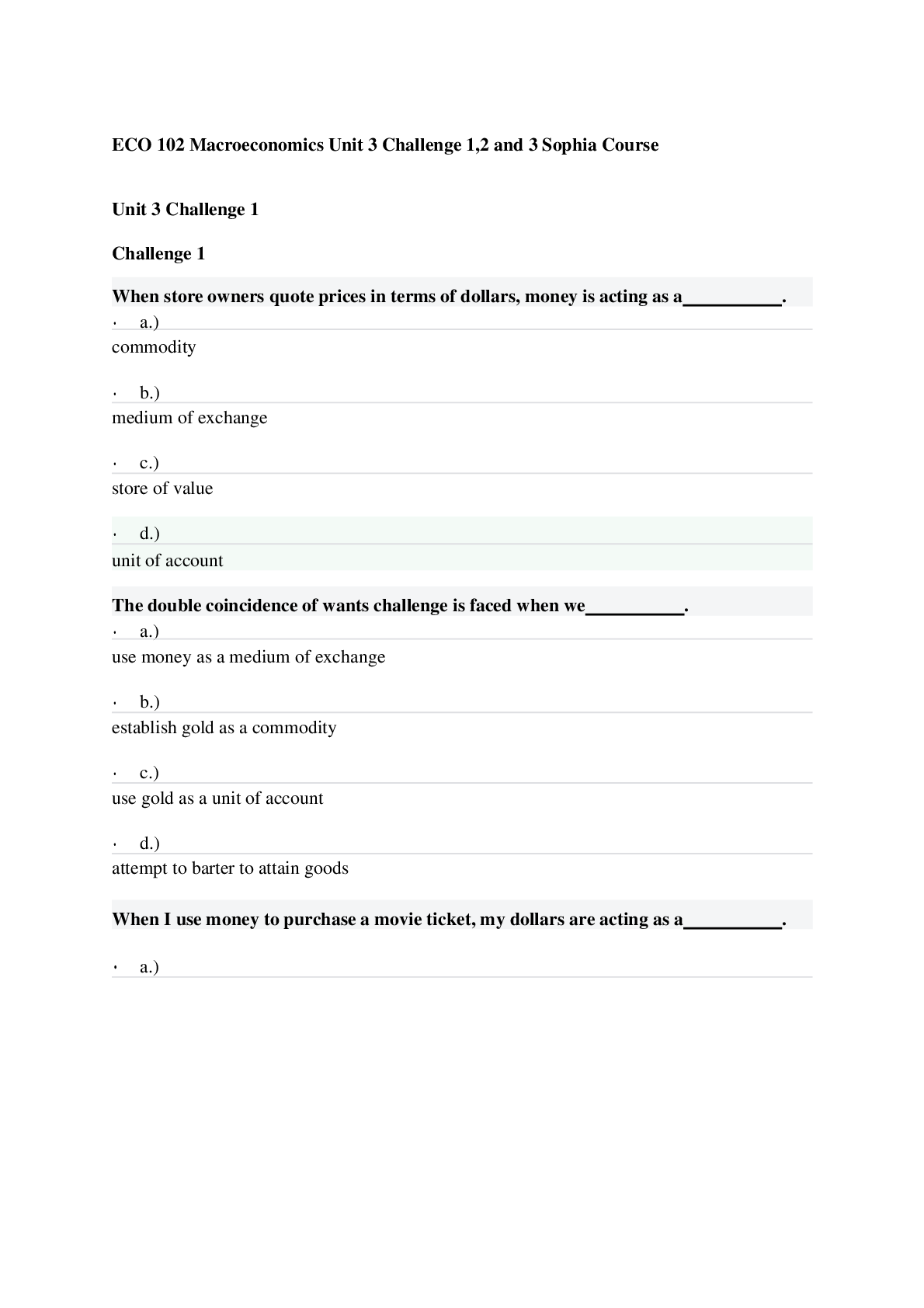
Buy this document to get the full access instantly
Instant Download Access after purchase
Buy NowInstant download
We Accept:

Reviews( 0 )
$14.00
Can't find what you want? Try our AI powered Search
Document information
Connected school, study & course
About the document
Uploaded On
Sep 12, 2022
Number of pages
23
Written in
All
Additional information
This document has been written for:
Uploaded
Sep 12, 2022
Downloads
0
Views
112

 2021.png)
